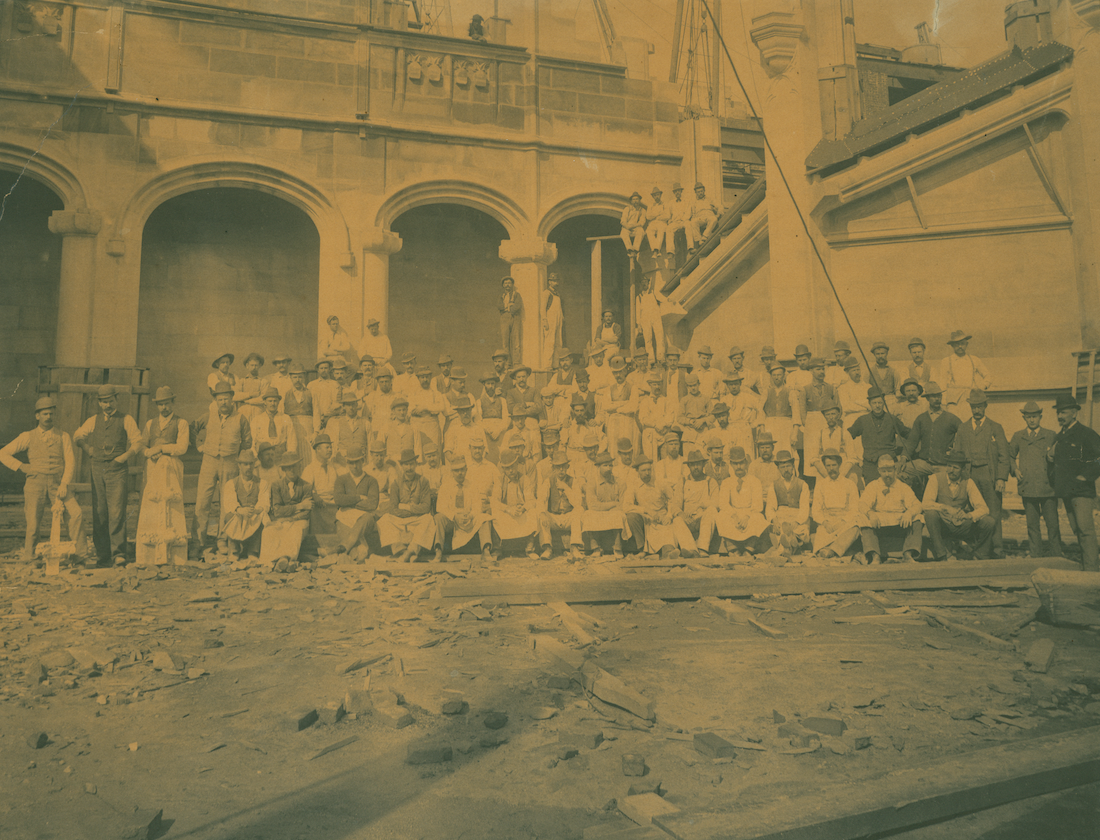In 1891, workers at the Biltmore Estate were in the midst of laying the foundation of the South Terrace. That same year, the Asheville Daily Citizen ran a short piece based on an unverified tip, promoting a popular racist trope: white men protecting communities against violent Black males.
Featured on the front page of its Sept. 14 edition, the paper asserted 500-600 of the estate’s Black employees had arrived intoxicated at the property to receive their weekly pay. Cursing and fighting soon commenced, the article claimed. “[A] riot was for a time probable,” the paper declared, “avoided only by the coolness of two white men.”
The story elicited a series of letters to the editor refuting the Daily Citizen‘s claims, including a detailed account of the day’s events by Charles McNamee, the estate’s first manager and George Vanderbilt’s attorney.
McNamee began by correcting the paper’s figures, noting that the estate employed roughly 300 Black workers. In addition, employees were paid on an alternating schedule to avoid an overwhelming number of workers arriving on a single day. “Last Saturday, when it is stated that a riot was imminent, there were 228 men in all on the roll for payment,” McNamee continued. “A large number of these 228 were white men.”
Not denying the presence of alcohol, McNamee wrote, “It is a fact that liquor is in some way procured at Biltmore, and there is consequently, at times, some intoxication, among both the white and the colored men.”
Furthermore, McNamee acknowledged, “There is doubtless more or less cursing [among workers], though I do not remember that it has ever been so loud or deep as to attract any attention.”
The estate’s manager concluded his letter by “emphatically denying practically everything that the informant of THE CITIZEN stated[.]”
In response, the paper briefly noted the information it had received “was perfectly sincere,” and thus “THE CITIZEN printed it in good faith as a matter of news.”
Five additional citizens signed their names to letters denying the paper’s account.
Racial tension and violence marked subsequent headlines throughout the 1890s and its surrounding years. Less than two weeks after the false report of a riot, Hezekiah Rankin, a local African American brakeman, was lynched — one of three reported lynchings to occur in Buncombe County from 1889-97. (For more, see “Asheville Archives: ‘A growing evil,’” May 15, 2018, Xpress)
Asheville’s subsequent decade began with a July 30, 1900, white supremacy march on the city’s downtown streets. The event took place three days before North Carolina’s eligible male voters approved an amendment to the state constitution that actively sought to disenfranchise Black voters.
“The amendment has been ratified, and the government of state and county has been committed to the party which stands for white supremacy, by overwhelming majorities,” the Asheville Daily Citizen wrote on Aug. 2, 1900. “And it is hoped that the lesson of this result will not be lost on those partisans and theorists, here and elsewhere, who have thought it possible for the white men of their country to yield any considerable share in their government to an alien and inferior race.” (For more, see “Asheville Archives: ‘White supremacy made permanent,’ 1900,” Feb. 6, 2018, Xpress)
Editor’s note: Peculiarities of spelling and punctuation are preserved from original documents.




I think the Biltmore House needs to be dismantled block by block vis-a-vis the Vance Monument. Obviously a cover-up by/on their uber privileged end of things. Leave no stone unturned you know. That, or it needs to be turned into a low-income housing venue… now that would make a statement our more progressively minded Ashevilians could proudly and loudly tout in regard to the whole who goes first and biggest in the reparations drama. I’m down for it ;) Oh, and thank you for this brief article… it is important that we’re reminded of these awful things… injustices.
The Biltmore Estate is privately owned. Why don’t you buy it and you can do with it as you please. It shouldn’t be more than a couple hundred mil.
No, really…. it’s privately owned? You don’t say. Those Vanderbilts… they don’t know quit, do they? Who knew? Lol…
Disenfranchise Black voters? Unthinkable. Thank goodness nothing like that could happen today.
It isn’t the Vanderbilts who know not when to quit. They donated The Breakers a long time ago, and now it is run for the benefit of the public and run by a non-profit. Biltmore Estate is owned by the Cecils, who are descended from William Cecil, the advisor to Queen Elizabeth I.
I knew a fellow who said that the only way that George Vanderbilt could make Cornelia a lady was marry her to a Lord. Said Lord’s sond and progeny run it now, and the Vanderbilts have little to nothing to do with it.
This is just another Gilded Age mansion, paid for and constructed with the sweat and sometimes blood of poor people. The Vanderbilts had the decency to donate The Breakers (or did it just cost too much to operate?) to the American People, but the Cecils are not going to do that, as the Estate is such a big money machine.